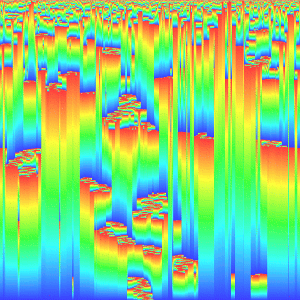Bak–Sneppen model
The Bak–Sneppen model is a simple model of co-evolution between interacting species. It was developed to show how self-organized criticality may explain key features of the fossil record, such as the distribution of sizes of extinction events and the phenomenon of punctuated equilibrium. It is named after Per Bak and Kim Sneppen.

The model dynamics repeatedly eliminates the least adapted species and mutates it and its neighbors to recreate the interaction between species. A comprehensive study of the details of this model can be found in Phys. Rev. E 53, 414–443 (1996). A solvable version of the model has been proposed in Phys. Rev. Lett. 76, 348–351 (1996), which shows that the dynamics evolves sub-diffusively, driven by a long-range memory.
An evolutionary local search heuristic based on the Bak–Sneppen model, called extremal optimization, has been introduced in Artificial Intelligence 119, 275–286 (2000). The Bak–Sneppen model has been applied to the theory of scientific progress.[1]
Description
We consider N species, which are associated with a fitness factor f(i). They are indexed by integers i around a ring. The algorithm consists in choosing the least fit species, and then replacing it and its two closest neighbors (previous and next integer) by new species, with a new random fitness. After a long run there will be a minimum required fitness, below which species don't survive. These "long-run" events are referred to as avalanches, and the model proceeds through these avalanches until it reaches a state of relative stability where all species' fitness are above a certain threshold.[2]
See also
References
- De Langhe, Rogier (2014). "A comparison of two models of scientific progress". Studies in History and Philosophy of Science. 46: 94–99. doi:10.1016/j.shpsa.2014.03.002. PMID 25051877.
- Wei1, Li; Yang, Luo; YuanFang, Wang & AiPing, Cai. "A mean-field Bak-Sneppen model with varying interaction strength". Chinese Science Bulletin, 2011, p. 3639.
- Bak, P. (1996). How Nature Works: The Science of Self-Organized Criticality. New York: Copernicus. ISBN 0-387-94791-4.
- Bak, P.; Kim Sneppen (1993). "Punctuated equilibrium and criticality in a simple model of evolution". Physical Review Letters. 71 (24): 4083–4086. Bibcode:1993PhRvL..71.4083B. doi:10.1103/PhysRevLett.71.4083. PMID 10055149.
- Kim Sneppen (1992). "Self-organized pinning and interface growth in a random medium". Physical Review Letters. 69 (24): 3539–3542. Bibcode:1992PhRvL..69.3539S. doi:10.1103/PhysRevLett.69.3539. PMID 10046847.
- Li Wei1; Luo Yang; Wang YuanFang & Cai AiPing (2011). "A mean-field Bak-Sneppen model with varying interaction strength". Chinese Science Bulletin. 56 (34): 3639–3642. Bibcode:2011ChSBu..56.3639L. doi:10.1007/s11434-011-4654-1.
External links
- Bak–Sneppen Evolution Model as an interactive java applet. Dead link 2019114